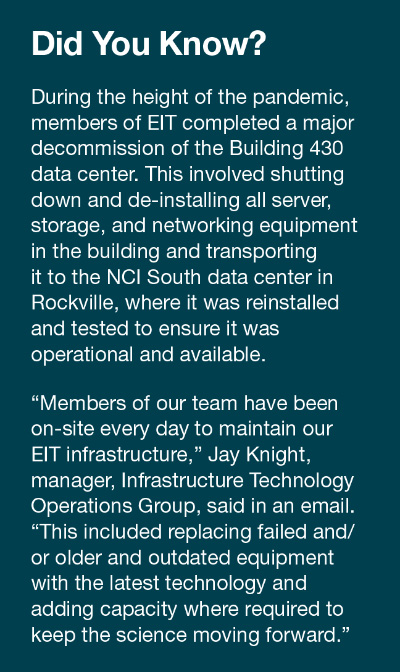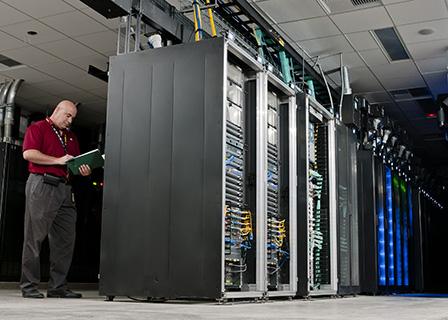At the height of the pandemic in March 2020, employees from across the National Cancer Institute at Frederick and the Frederick National Laboratory joined in the mass exodus from workplaces across the country, going to work from their homes in an effort to slow the spread of SARS-CoV-2.
Many FNL employees had never worked remotely, however. They had to rely on the expertise—and patience—of the Enterprise Information Technology (EIT) Directorate to help them transition from working on-site to working from home.
In the ensuing two and a half years, the more than 150 members of EIT ensured that meetings could be held virtually, that all security protocols were met, that sensitive laboratory data was saved, and that laptop computers kept employees connected.
It was—and continues to be—a daunting undertaking, especially since some employees continue to work remotely. “But I am confident that we have continued to be productive to support NCI at Frederick and FNL with their IT needs,” said Brett Smith, EIT director.
‘All Hands on Deck’
When the National Institutes of Health (NIH) announced that all eligible operations would go remote at the start of the pandemic, Stephanie Halling, Computer & Statistical Services (C&SS) Client Services principal manager, and her team of 10 technicians hurried to configure upwards of 200 laptops in less than two weeks for employees who would be working remotely. “We had to install the basic operating systems, VPN access, and software packages,” she recalled. “It was an ‘all hands on deck’ operation.”
But before they could even do that, they had to collaborate with the FNL Property Compliance team to pull laptops, monitors, iPads, and printers from storage for those who requested them. “We were slammed,” said Quentin Jackson, a Property Compliance logistics analyst.
The five-person Property Compliance team also ensured that every piece of equipment could be tracked and accounted for once it left their hands. As proof of the fact that innovation is often borne from adversity, the department developed a more efficient way to monitor their inventory. “We changed from an equipment loan process to a 90-day renewable pass process,” said Joshua Cummings, a Property Compliance logistics support associate. “That helped streamline the process since we didn’t have to track down a lot of signatures.”
Managing Security, Building Capacity
 While the C&SS and Property Compliance teams were hurriedly configuring and issuing equipment, other members of EIT had to make sure that the Data Center’s servers remained fully operational and that employees were following all of NIH’s security protocols, even amid remote work challenges.
While the C&SS and Property Compliance teams were hurriedly configuring and issuing equipment, other members of EIT had to make sure that the Data Center’s servers remained fully operational and that employees were following all of NIH’s security protocols, even amid remote work challenges.
The EIT Information Security and Compliance team ensured that users’ workstations were configured to meet security requirements despite their remote locations. The group also monitored external threats, such as the SolarWinds and Log4j hackings that could have threatened the entire NIH network.
“It was challenging at times, but I think our team adapted very quickly,” said Natasha Freeman, director of EIT Information Security and Compliance.
Chris Knill, C&SS program director on the EIT Systems Infrastructure team, said most of his team members shifted to remote work with little disruption. “It was shocking how smooth the transition was,” he said. “Occasionally we had to have some people on-site, particularly if there was an issue with a server in the Data Center. But we continued to get the job done.”
Much of the credit for that goes to EIT Systems Infrastructure engineers on Knill’s team, who help scientists capture and save their experimental data and findings. When work went remote, the need to ensure safe and proper storage of that material became even more urgent than usual.
Business as Usual
Amid all the pandemic upheaval, the business behind the science continued as well—regardless of where people were working. Employees carried on with their professional development training, completed their annual assessments, and managed their timesheets and pay.
Parag Ghodgaonkar, director of Business Enterprise Systems within EIT, and his team continued to implement and manage many of the key initiatives that support NCI Frederick and FNL operations. These include applications such as Costpoint, EDGE training and development, Achieve performance management, ServiceNow Help Desk ticketing, and the LabVantage laboratory information management system.
“The challenge has been to make sure my team has a clear understanding of their projects and that they make use of the technologies and tools we have to disseminate essential information to our stakeholders,” he said. He believes everyone—his team and their customers—have risen to the challenge. “The whole FNL community has been very flexible and adapted well,” he added.
Learning and Adapting
Across EIT, adapting and learning have been key to meeting every challenge over the last two years. “The support of the IT groups and their ability to pivot and not lose a step is paramount to the science that is being done,” said Rich Pendleton, FNL’s director of Business Operations.
Nowhere has that been more apparent than with the FNL Conference Center Audiovisual team, where supervisor Jason Tait and his staff shifted from on-site meetings of several hundred attendees to virtual events for large groups, such as the Technology Showcase and the Spring Research Festival.
“These events might require us to create breakout ‘rooms,’ chats, and scheduling time slots for presenters,” he said. Although in the beginning, it might have felt as though his team was herding cats, Tait says everyone, including presenters, quickly got the hang of it. “When we first started, not everyone was savvy with how to participate in online meetings, but people know what they are doing now.”
At the Help Desk, Mary Leatherman, Microcomputer Support (MCS) Tech Group team lead, also watched customers become more comfortable with remote work throughout the pandemic. For many users, simply knowing that Mary and her co-workers could gain remote access to their computers to work out bugs and install new programs was a comforting safety net that made the challenges of remote work a little less daunting.
Although Mary’s team worked remotely at the onset of the pandemic, they are now on-site again. But she takes pride in knowing that EIT’s behind-the-scenes contributions have been crucial to supporting the science of NCI Frederick and FNL.


